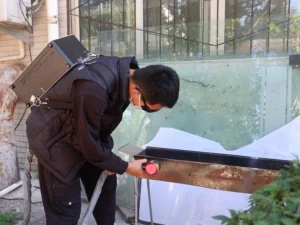Introduction:
Laser cleaning machines are widely used, and they can be used in aerospace, automobile manufacturing, electronics, semiconductors, raw material processing, and other fields. Especially for some industries with high process precision and difficult-to-achieve cleaning effect by using traditional cleaning methods, such as the semiconductor production industry, tire industry, and automobile manufacturing industry, laser cleaning machine has an excellent application prospect.
Laser cleaning is a new type of industrial surface treatment technology. It has the characteristics of being non-abrasive, non-contact, and suitable for various processing environments and materials. The cleaning process does not require the use of chemicals and consumables. It is today’s most reliable, effective, and environmentally friendly industrial-grade surface treatment. It is also the future development trend of industrial cleaning.
This article will help you determine the appropriate power level when selecting a laser cleaner.
How To Choose The Power Of A Laser Cleaning Machine?
Here are some considerations to help you determine the appropriate power level:
1. Rust Thickness and Adhesion:
The power of the laser cleaning machine should correspond to the thickness and adhesion strength of the rust. More powerful lasers can handle thicker layers of rust and remove it more efficiently. A higher-power laser may be necessary if you primarily deal with heavy rust or stubborn deposits.
2. Surface Material and Sensitivity:
Different materials have varying sensitivity to laser energy. Consider the material of the surface you are cleaning and its sensitivity to heat and laser energy. Different materials require different power levels to prevent damage. For example, metals can generally withstand higher-power lasers, while delicate surfaces like plastics or painted materials may require lower-power lasers to avoid surface damage.

3. Cleaning Speed:
The power of the laser cleaning machine affects the cleaning speed. Higher-power lasers can clean surfaces faster due to their increased energy output. A higher-power laser may be preferred if you require higher production rates or need to clean large areas within a limited time.
4. Safety Requirements:
Take into account safety considerations and regulations associated with higher-power lasers. Higher-power lasers emit more intense laser radiation, possibly requiring additional safety precautions and protective measures. Ensure you comply with safety guidelines to protect the operator and the environment.
5. Cost Considerations:
Higher-power laser cleaning machines tend to be more expensive than lower-power ones. Consider your budget and the cost-effectiveness of the equipment while balancing it with the required cleaning performance. It’s essential to strike a balance between the desired power and affordability.

6. Application Requirements:
Evaluate the specific cleaning applications you intend to perform. Some applications may require higher-power lasers, such as industrial cleaning of heavily rusted machinery or large-scale rust removal projects. Other applications, such as delicate surface cleaning or precision cleaning tasks, may benefit from lower-power lasers.
7. Budget:
Laser cleaning machines with higher power options tend to come at a higher price point. Consider your budget and cost-effectiveness when choosing the power level. Balance your requirements with the available budget.
Conclusion:
In summary, when choosing the power of a laser cleaning machine, assess factors such as rust thickness, surface material, cleaning speed requirements, safety considerations, cost, and specific application needs. It’s advisable to consult with laser cleaning machine manufacturers or industry experts who can provide guidance based on your specific requirements.
